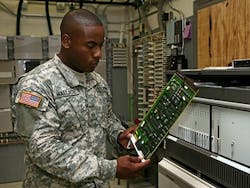Thermal management is a large and growing pain point for military circuit board manufacturers
That's the word from a global biennial study published this month by a notable printed circuit board trade group on embedded computing and other kinds of board products in several industry sectors.
In addition to thermal management and electronics cooling, more than one-third of companies in the military and aerospace segment are embedding passive components in their boards today, and expect to increase that substantially by 2019, say analysts at the IPC-Association Connecting Electronics Industries in Bannockburn, Ill.
Results of the study is in a 173-page IPC report, PCB Technology Trends 2014, which shows how circuit board manufacturers are meeting today's technology demands, and the changes expected by 2019 that will affect circuit board fabricators and their suppliers of materials and equipment.
Nearly half of the responding circuit board manufacturers for computer and telecommunications applications expect their highest clock speeds in 2019 to exceed 25 gigahertz, the IPC study says. This segment had the highest clock speed predictions.
PCB Technology Trends 2014 is available free to companies that participated in the survey. Other companies may buy the report for $675 if they are IPC members, and for $1,350 if they are not.
The study is based on a survey of 158 companies worldwide, and presents the aggregate data segmented by application for five key segments: military and aerospace electronics; industrial and automotive electronics; medical electronics; computers and telecommunications; and consumer electronics.
The study covers clock speeds, heat dissipation, operation cycles, product life expectancy, environmental operating range, lamination cycles, board thickness, layer counts, line width and spacing, via diameters, aspect ratios, use of embedded technologies, surface-mount land dimensions, I/O pitch, test density, recyclable content, component size, and numbers of leads, solder joints and components per board area.
For more information on the PCB Technology Trends 2014 market study contact IPC online at www.ipc.org/pcb-tech-trends-2014.

